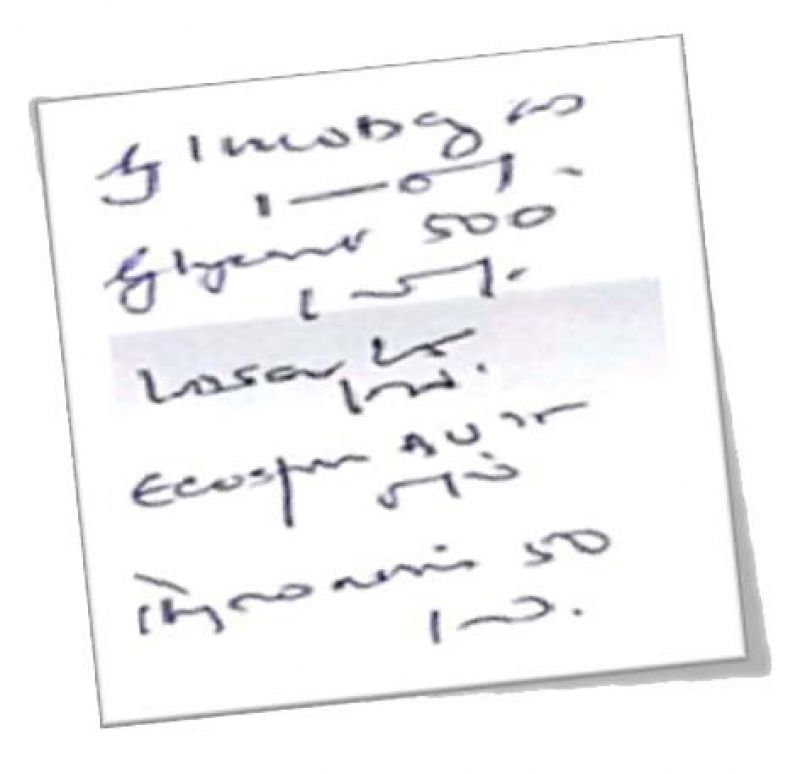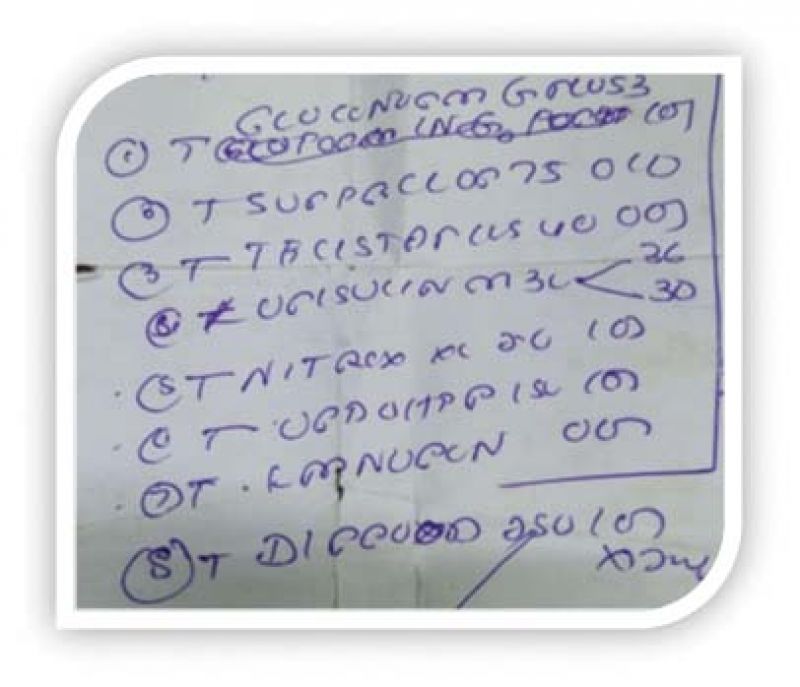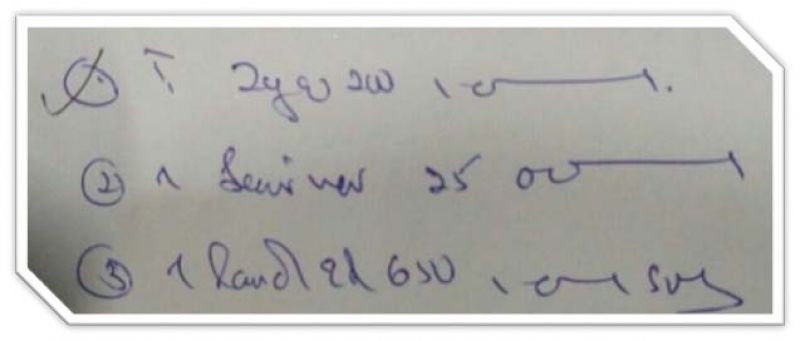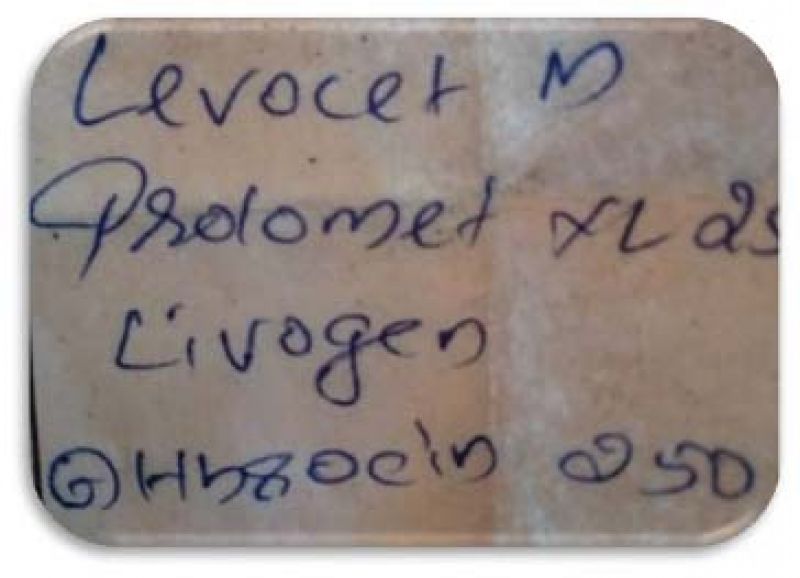It's time to totally ban handwritten prescription

Good handwriting is an asset for any educated person, like good voice for a musician. Many doctors have atrocious and illegible handwriting and it is a global problem irrespective of their specialty, position and designation.
From the perspective of patients, illegible handwriting in prescription writing is a nuisance, which could result in serious injuries, including death of the patients. It may compel patients to take wrong medicine and wrong dosage and can also lead to unnecessary tests and discomfort. Pharmacists may dispense wrong drugs.
Why illegible prescriptions?
There may be many reasons, including busy work. Many abbreviations, both popular and non-popular, approved and non-approved, often appear in prescriptions.
There are certain established conventions for prescription writing. Prescriptions have to be written with permanent ink avoiding decimal points and other ambiguities. Units like teaspoons or tablespoons have to be avoided. Directions should be used in full English. If some Latin terms are used, pharmacists have to translate them into words understood by patients. In case of an illegible hand-written prescription, the pharmacist or pharmacy technician must contact the prescriber for clarification before dispensing.
Reports and studies
In 1999, the Institute of Medicine (IOM), USA, released a study report To err is human: Building a safer Health System. It revealed that 44,000 to 98,000 people die annually in USA from medical errors. Out of them, about 7,000 deaths are attributable to sloppy handwriting. The report estimated a national cost of $17 to 29 billion for the preventable adverse events in health care. In UK, about 30,000 British die every year due to medical errors. Illegible prescriptions do take a fair share of it.
Poor handwriting has caused a number of deaths of patients and increased the incidence of medical errors in India also. Since we don’t have a perfect data bank or correct registry, the exact numbers are not known.
Illegible handwriting in medical records too have caused adverse medico-legal implications.

A few years ago, the daughter-in-law of the former editor of a leading publication in Assam was admitted to GNRC hospital in Guwahati as she was suffering from convulsions. The examination and investigations could not pinpoint a particular reason. However, a staff nurse could reveal that a doctor in Delhi had prescribed her ‘Duodil’ a drug for muscle spasm and resultant pain and discomfort.
Because of the quality of handwriting, she was dispensed a drug ‘Daonil,’ a medicine for diabetes, by the pharmacist in a pharmacy. She was taking it for a few days. This caused a sudden fall in her blood sugar levels, leading to the convulsions. Such a grave consequence was mainly due to the illegible handwriting of the doctor who treated her in Delhi.
Some studies have shown that male doctors are having far worse handwriting than their female counterparts. Many times, the doctors themselves find it difficult to read their own handwriting at a later stage.
 A prescription written in capital letters still takes an experienced pharmacist some time to read it
A prescription written in capital letters still takes an experienced pharmacist some time to read it
It is also found that doctors handwriting is no better at home than in the hospital. Reading a doctor’s prescription has always been a challenge for the common man.
What is a prescription?
A prescription is not merely a chit for the patients to buy some items from a pharmacy or other store. It has a specified format and structure and requires the information about both prescriber and patient. Prescription itself is a health care programme implemented by the physician or other health care practitioners for a patient. It is an instruction manual for the patient or his/her family members/ caregivers. It is a documentation of drug requirement for the pharmacists and a track record of the patients’ past and present medication and disease conditions for other doctors and healthcare professionals. When a patient is referred to a senior or specialty doctor, the latter has to go through all associated prescriptions and investigations.
 Who can read this handwriting?
Who can read this handwriting?
In the past, prescriptions often included detailed instructions regarding compounding of medications. As medications became pre-packaged manufactured products, the prescriptions now refer to an order that a pharmacist has to dispense to a particular patient for specific medicines.
As medical practice has become increasingly complex, the term prescription has broadened to include clinical assessments and investigation reports aimed at optimising safety or efficacy of medical treatment.
It was John Morghan, the American apothecary who initiated prescriptions in the form of chit given to the patient in the 1750s in USA. Till then, prescriptions were mainly retained as a reference book by the doctors and apothecaries.
A standard prescription has four parts namely superscription, inscription, subscription and signature. Doctors, pharmacists and nurses are fully aware of the importance of all the four parts of the prescription, though some doctors make it a miserable document leaving to the interpretation of the pharmacists.
For the dispensing pharmacists, deciphering the handwritten prescriptions for certain branded medicines often requires the assistance of colleagues.
 Who can decipher the last drug as Althrocin 250 mg?
Who can decipher the last drug as Althrocin 250 mg?
Initiative of an Andhra pharmacist
An initiative by a pharmacist in Hyderabad in 2013 later forced the Medical Council of India in 2016 to instruct the doctors to prescribe medicines in clear and legible handwriting. Notification number MCI-211 (2)/2016 (Ethics)/131118 issued by the MCI in October 2016 directs the doctors to write prescriptions in capital or legible letters and prescribe medicines in generic names.
Chilukuri Paramathma, a pharmacist from Andhra Pradesh, approached the High Court of Hyderabad in 2014 against the prescription writing style leading to confusion in pharmacists through a public interest litigation. Citing a number of incidents, he brought to the notice of the court that pharmacists were giving wrong medicines to patients because of disastrous handwriting in prescriptions. In one case, a pregnant woman got aborted due to the wrong dispensing of medicines by a pharmacist in a pharmacy chain store at Vidyanagar in Hyderabad. At that time, the MCI was not having any guidelines for prescription writing, though the state of Maharashtra had framed a model prescription format under the initiation of the then FDA commissioner Mahesh Zagade.
Some typical prescriptions
In the past, students and interns were made familiar with typical miserable prescriptions through textbooks and study papers only. Such illustrations were often pretty old or from other countries. Because of WhatsApp and other electronic media for communication, such prescriptions now appear instantaneously in the media in these days. A study conducted by the author and his team in Kerala could find some interesting brand name prescriptions written by male doctors even after the decision taken by the Government of India, MCI and High Court orders for legible generic prescriptions.
Even after 20 or 30 years of experience, my practising pharmacist friends are struggling hard to decipher certain prescriptions written by some doctors. Being in an electronic age, they are smart enough to discuss such prescriptions using WhatsApp and other electronic media.
In the 1960s, when there were many prescription errors in USA, the Ralph Nader movement helped the patients to take such litigation to consumer courts and the hospitals were forced to pay huge compensations. As a result of this, the hospitals and community pharmacies initiated steps to invite highly qualified pharmacists with Pharm.D and M.S. Pharmacy qualifications to handle prescriptions and related professional activities. Today USA is one of the countries where medication errors are minimum, medicine safety is high and innovations are made in prescription handling and dispensing.
Digitising the patient records and prescriptions
In a country where digital India, e-governance, e-health and e-pharmacies are running at a pace, it is high time handwritten prescriptions are banned. In January 2017, the Bangladesh High Court ordered the government to issue a circular asking doctors to write prescriptions clearly in block letters or print the prescriptions. In March 2018, the Ministry of Health and Prevention of UAE banned handwritten prescriptions and said prescriptions have to be in electronic or printed format.
In September 2018, the Uttarakhand High Court at Nainital directed all doctors whether in government, public or private clinics and hospitals to issue computer-generated prescriptions and not handwritten ones so that patients and their care givers understand them. A division bench consisting of acting chief justice Rajiv Sharma and justice Manoj Kumar Tiwari issued the order while hearing a review petition based on the August 14 order for generic prescriptions by doctors.
The court also directed the government to provide necessary infrastructure to government doctors in this regard. The reading of prescription will no longer be a challenge for the common man in Uttarakhand.
It may also be noted that through its order dated August 14, 2018 the High Court of Uttarakhand directed all doctors in the state to prescribe only generic medicines and not force patients to buy costly branded medicines.
Computer application and digitisation of patient records and prescriptions will help solve many medication-related problems, including illegible handwriting. Doctors and other healthcare professionals, including nurses and pharmacists, can quickly access the patient data without errors.
Easy access to various patient data will also help in various types of studies and research which can lead to an overall improvement in the quality and effectiveness of healthcare.
Many doctors with bad handwriting at global level are now entering orders and note electronically suo motu and use even electronic signature.
Compared to complicated chemical name, generic name is a shortened, popular, easy-to-recognise name in pharmaceutical sector.
Brand name or trade name is a proprietary, fancy, business name given by the manufacturers to distinguish their products from that of others. In all academic activities, only generic name is used. Generic name being the scientific and official name, almost all countries follow the system of prescription writing and dispensing based on generic name of the medicines.
Health insurance agencies, World Health Organisation, international, national and regional medicine procurement agencies all follow the generic system.
Miserable prescriptions
Prime Minister Narendra Modi announced on April 17, 2017 that the Government of India intended to ensure that doctors prescribe medicines by generic name only as they are cheaper than the respective branded medicines. He also said that the doctors write prescriptions in such a way that the poor people do not understand their handwriting and they end up buying costly medicines while quality generics are available at lower costs.
“We will bring in a legal framework by which if a doctor writes a prescription, he has to write generic names in a legible manner,” he said.
The very next day, the Union Ministry of Health and Family Welfare wrote to the additional chief secretaries/ principal secretaries of health and family welfare of all states and Union Territories calling their attention to the October 2016 MCI notification mandating prescribing drugs with generic names legibly and preferably in capital letters. They must also furnish a complete and detailed prescription to ensure that there is no chance of incorrect treatment.
On April 21, 2017, the MCI directed the entire medical community in India to follow its October 2016 notification. Various state medical councils, including the Travancore-Cochin Medical Council of Kerala, endorsed the decision and directed the practitioners to comply with the same.
Although a good move from MCI, this protocol is hardly being adhered to by certain practitioners as there is no monitoring mechanism to its adherence. This is a grave cause of concern. Studies have shown that in rural India, only one in five doctors writes legible prescriptions and only half of the Indian doctors really sign the prescriptions written by them.
Doctors obey only court orders?
While many doctors dare to ignore government and MCI directions, they seem to obey the court directions with fear and respect. Even those with miserable handwriting start writing prescriptions in a legible manner.
The Lucknow bench of Allahabad High Court in the first week of October 2018 imposed a penalty of Rs 5,000 each on three doctors- Dr T.P. Jaiswal of Unnao, Dr P.K. Goel of Sitapur and Dr Ashish Saxena of Gonda district hospitals of UP on separate criminal cases for their poor and illegible handwriting. These hospitals are 100 to 200 kilometres apart, but their doctors have a common style of writing. The bench consisting of Justice Ajai Lamba and Justice Sanjay Harkauli considered their illegible handwriting as an obstruction to court work and admonished them and asked them to deposit Rs 5,000 each as penalty and deposit it in the library of the Bar Association within three weeks.
These doctors issued medico-legal reports of the victims in miserable handwriting and was not readable. They all pleaded that they were overburdened and hence erred in writing legible injury reports. The court also suggested that such reports should be computer-typed.
“The medical reports are written in such a shabby handwriting that they are not readable and decipherable by advocates or judges. It is to be considered that the medico-legal reports and postmortem reports are prepared to assist the persons involved in dispensation of criminal justice,” the court observed.
The court also directed the home secretary, health secretary and the director of health services of UP to ensure that in future medico-legal reports are prepared in easy language and legible handwriting.
As an after effect of the High Court order, the Mahatma Gandhi Medical College, Indore, Madhya Pradesh, came forward with a plan to train the medical students for improving their writing skills so that they can write prescriptions and medical reports in a legible manner.
Such initiatives should be part of the medical curriculum and all doctors have to attempt to acquire such writing skills.

